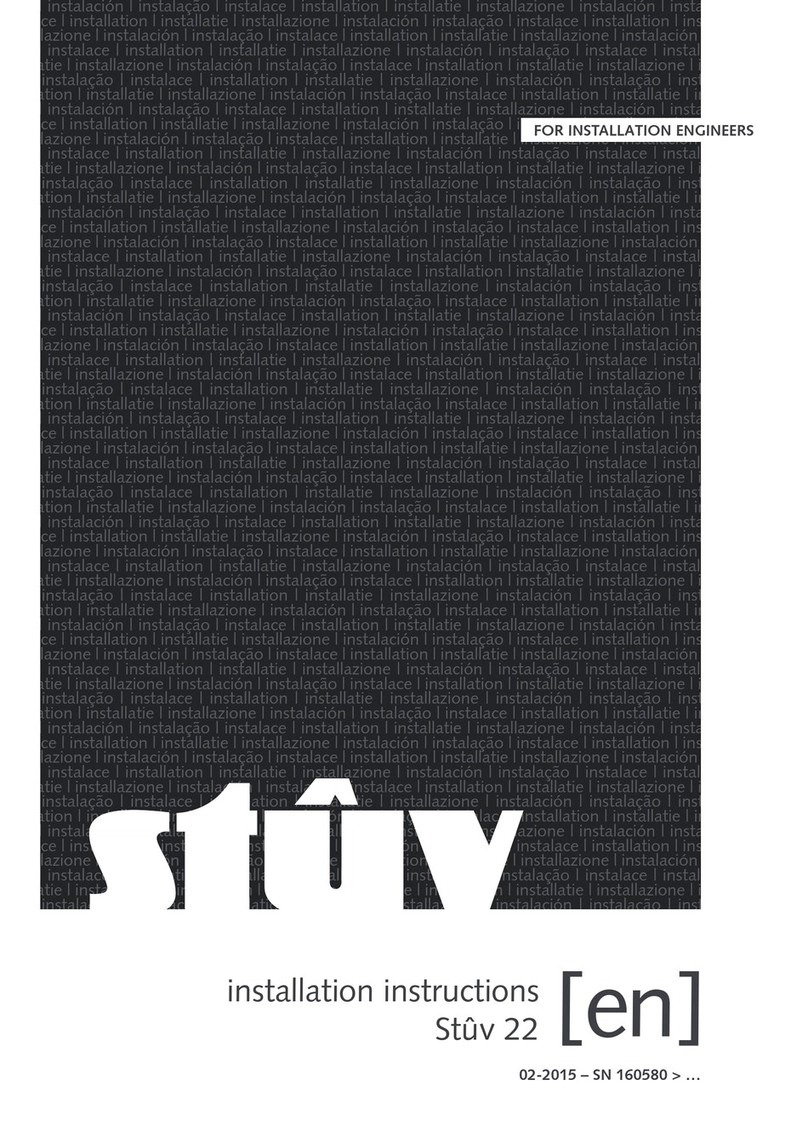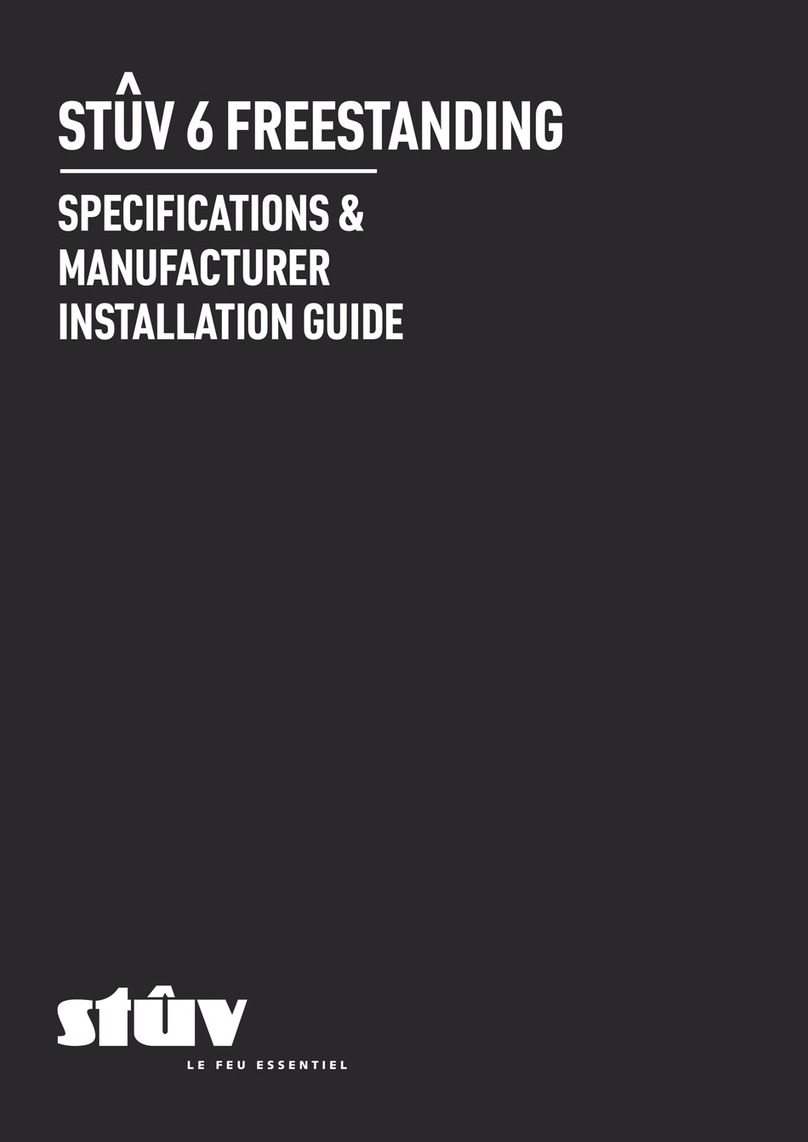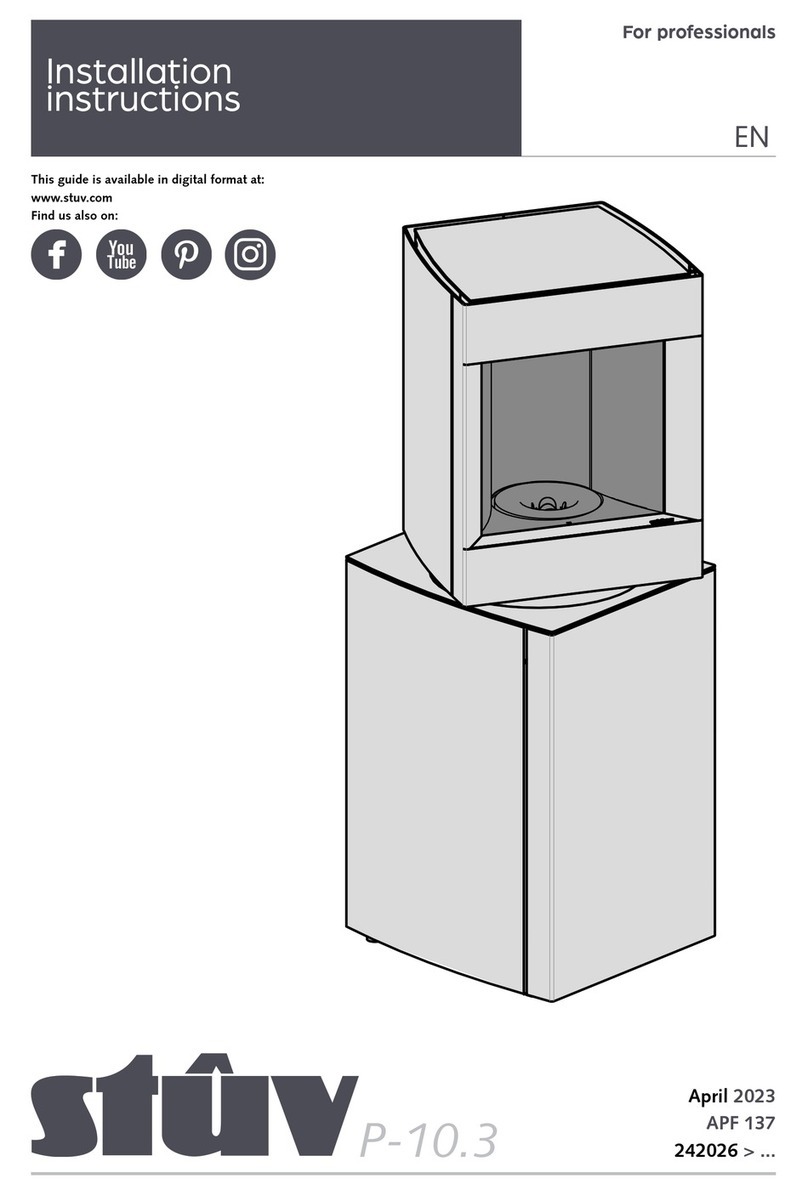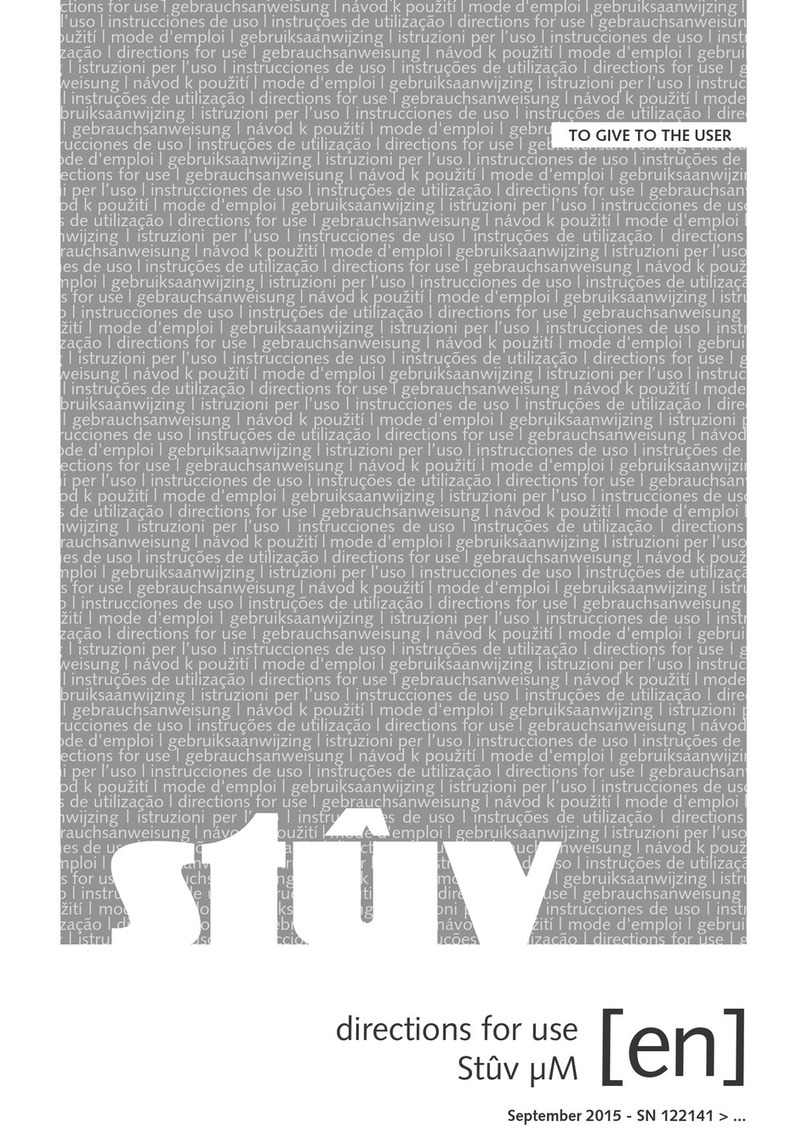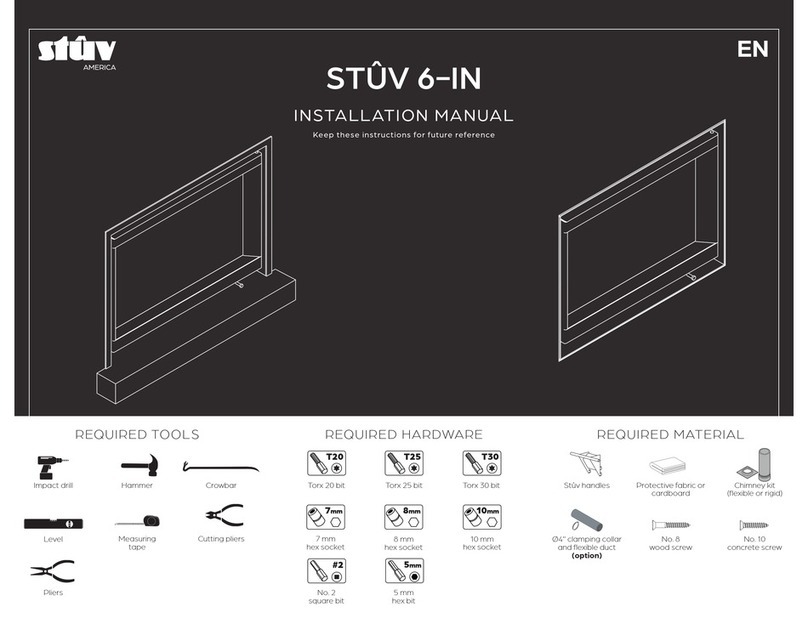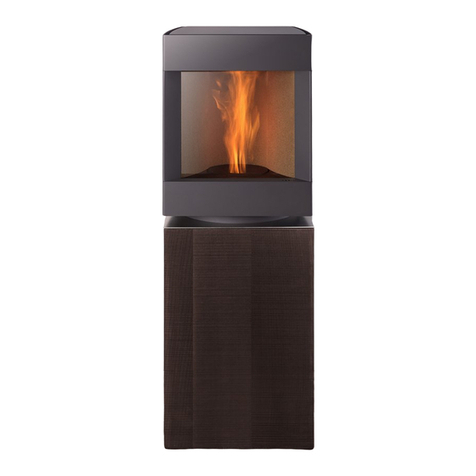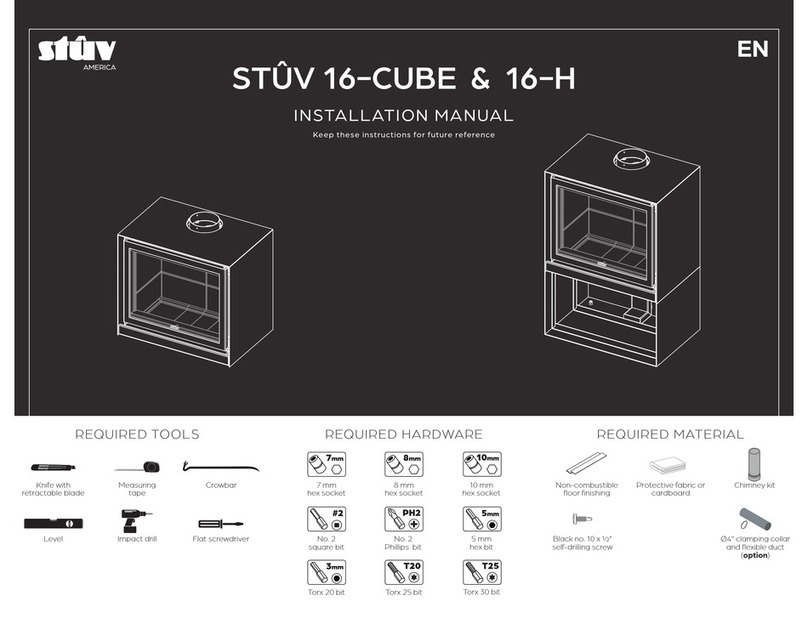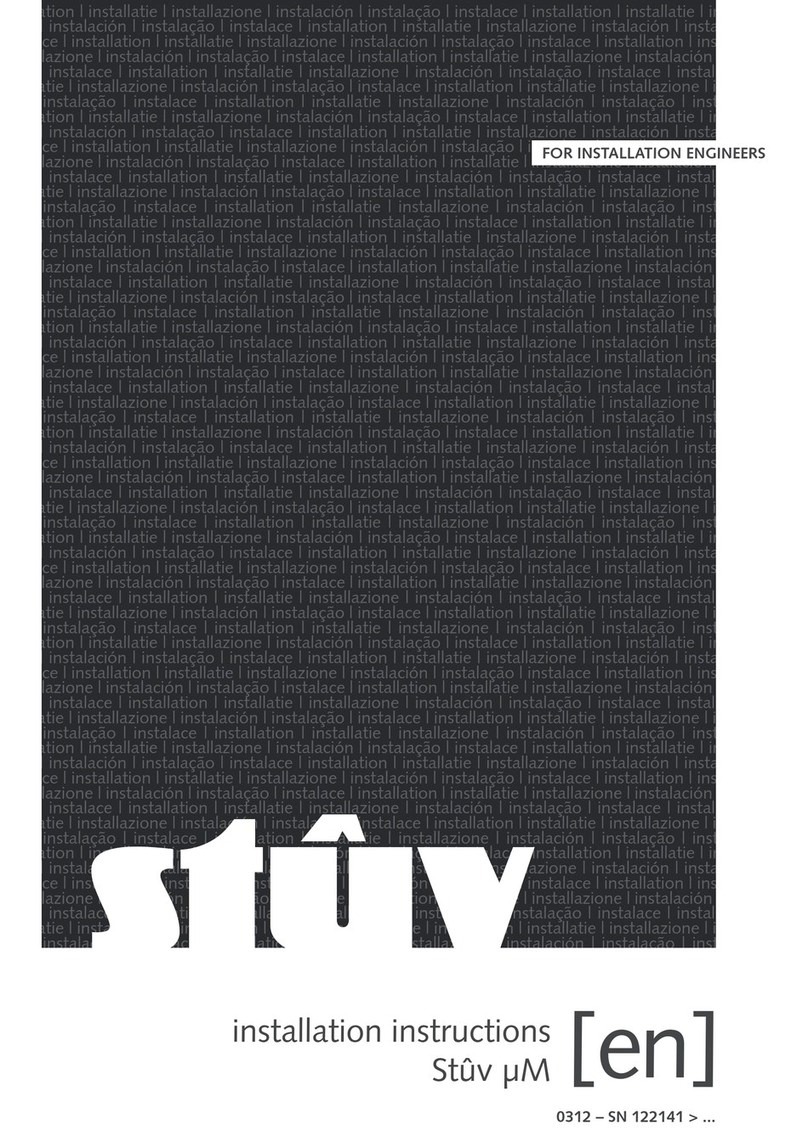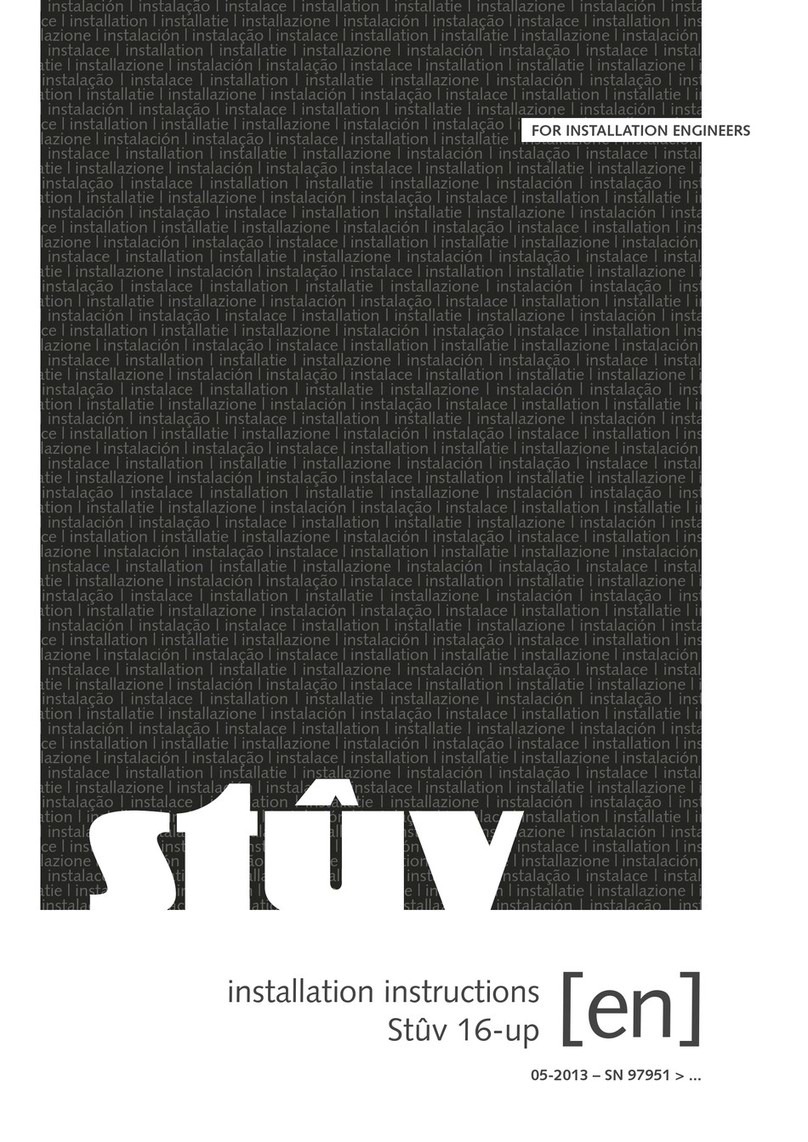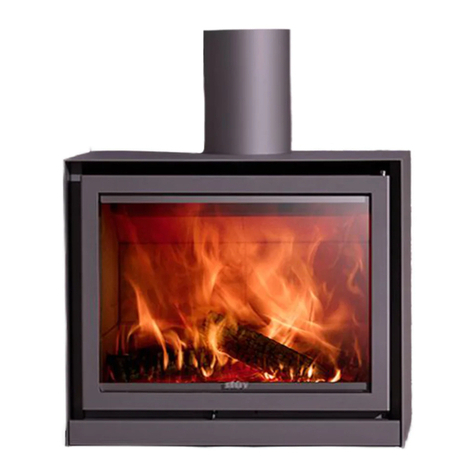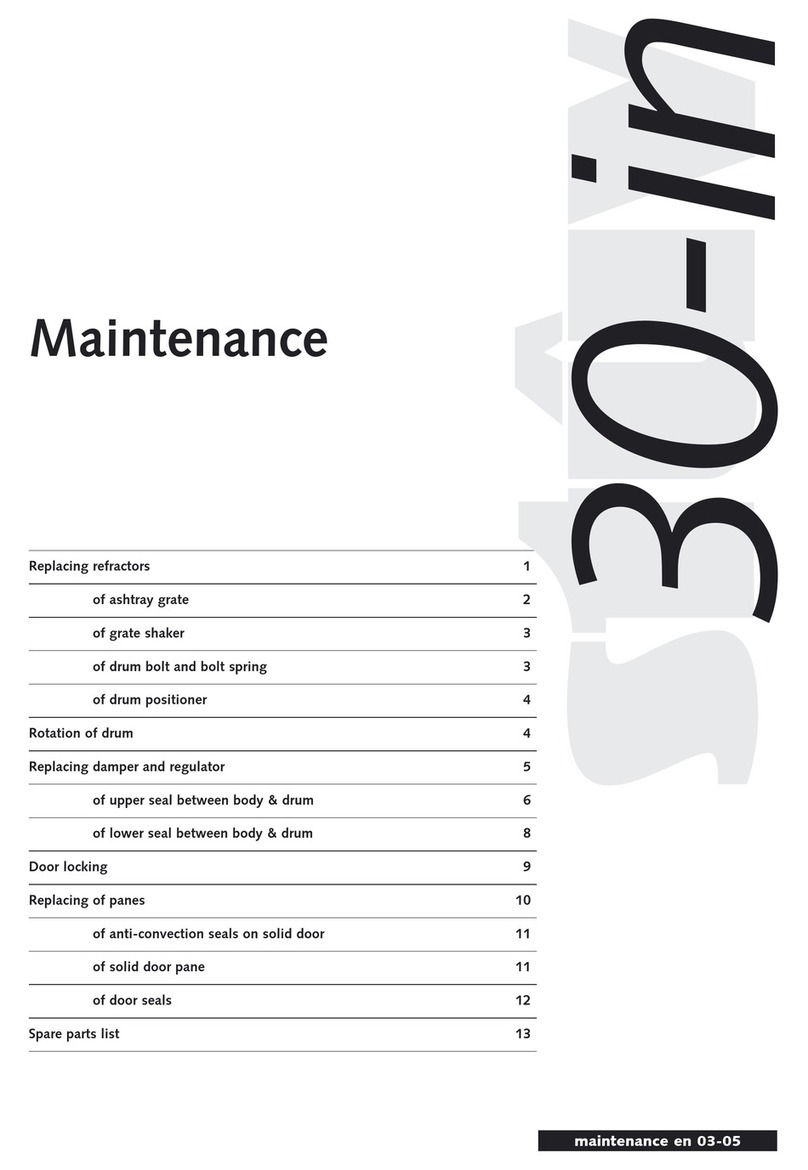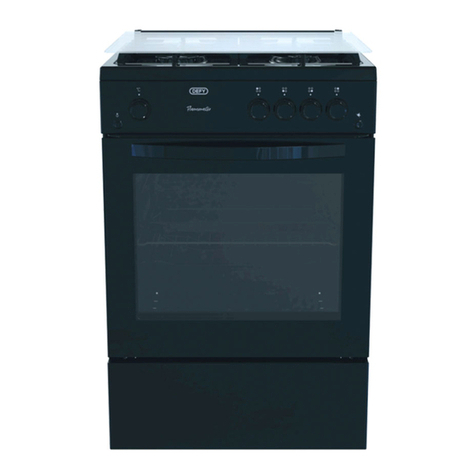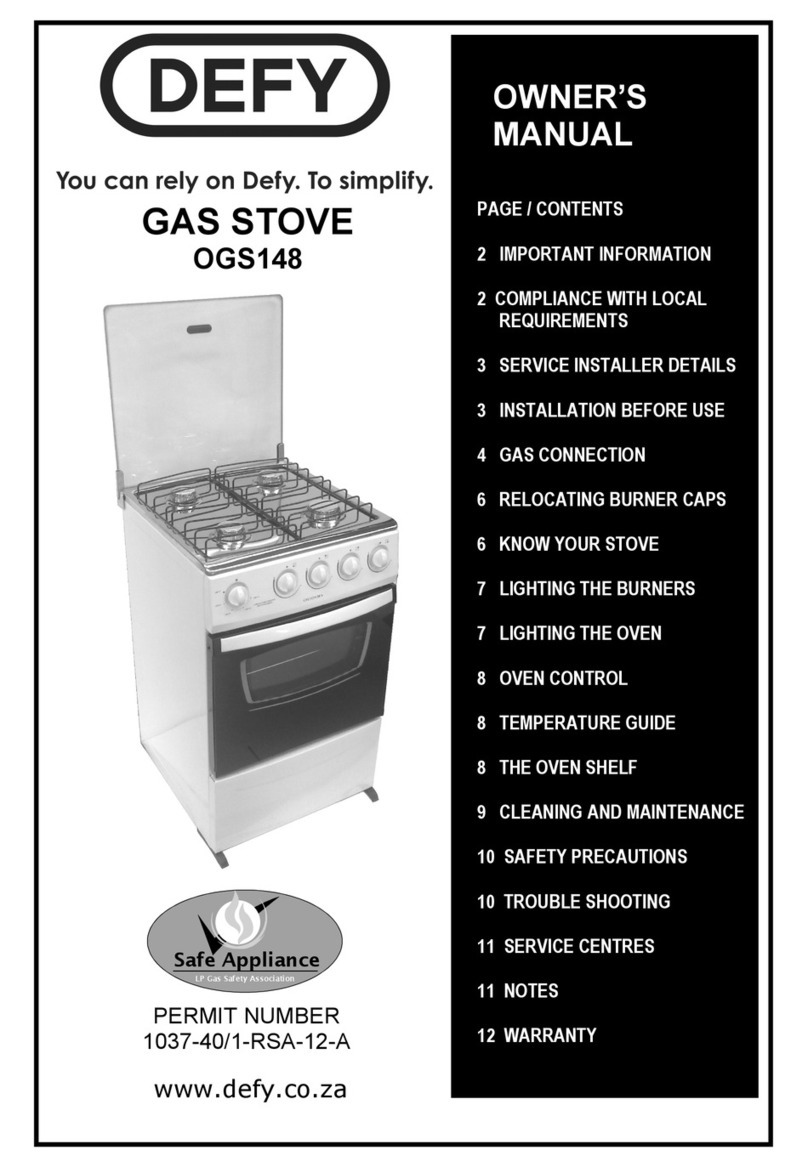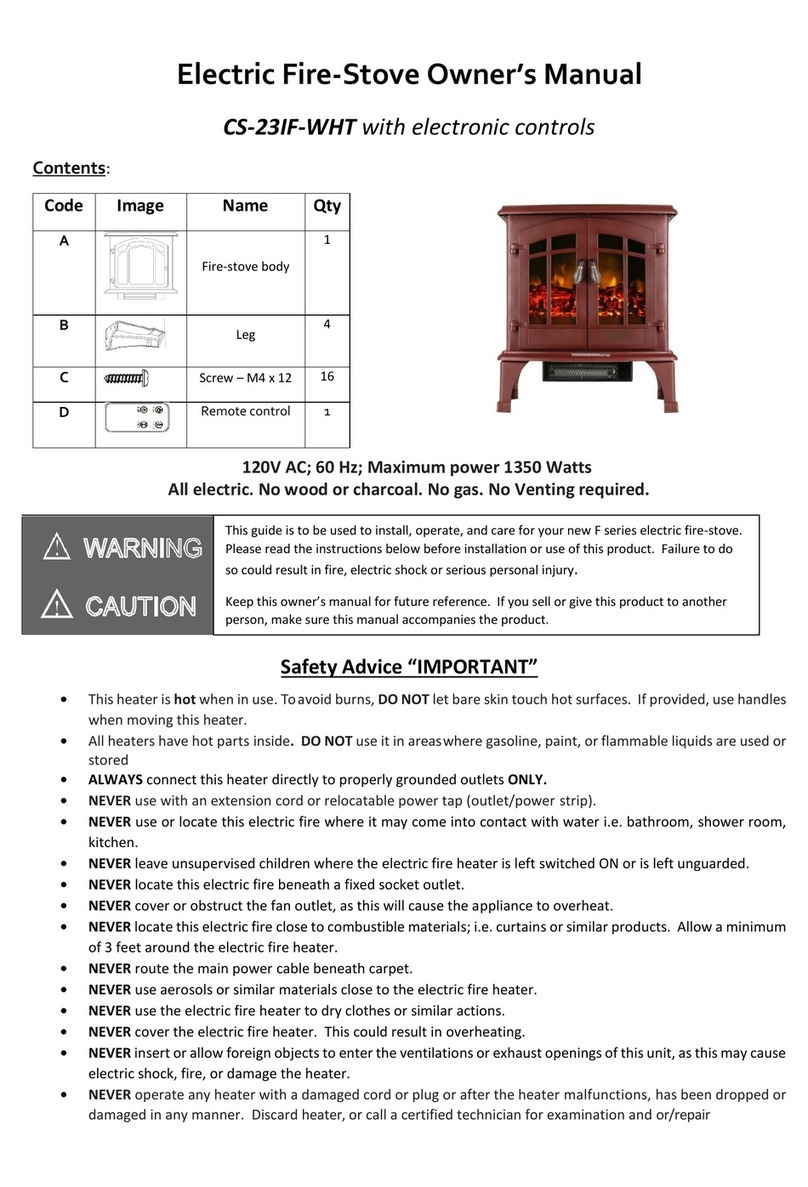Stuv 16/58-cube User manual

16-cube & H


3
[en]
Technical specifications 4 » 8
Site preparation 9 » 14
Installation 15 » 24
Directions for use 24 » 25
Product registration and contact 30 » 32
[fr]
Présentation du produit 4 » 8
Préparation du chantier 9 » 14
Installation 15 » 24
Mode d’emploi 24 » 25
Enregistrement et contact 30 » 32
Maintenance26 » 29 Entretien 26 » 29

4
Your fireplace was designed to provide years of
enjoyment, comfort, and safety. It was built and
assembled with the greatest care. If, for any reason, you
are dissatisfied with your fireplace, please contact your
retailer.
We recommend that you read the instructions before
proceeding with the installation.
With certain configurations, the sequence of operations to
be performed may slightly vary.
Standards, certifications and technical
specifications
This appliance has been tested and certified by CSA
based on the following standards:
UL STD 1482
ULC STD S627
EPA EXEMPT
ASTM
Safety instructions
Before installing your Stûv, please contact the local
building authorities or the fire department and follow their
directives.
The installation of your Stûv should be entrusted to a
skilled professional.
If the Stûv fireplace is not properly installed, a fire could
result.
Your Stûv can be very hot: children and domestic animals
should not touch the fireplace when operating.
Combustible materials, such as firewood, wet clothes,
etc., placed too close to the appliance could catch fire.
Objects placed in front of the fireplace should be kept at a
distance of at least 48” (1.22m) from the glass front.
Do not let the fireplace heat up until some parts glow red.
Burn the firewood directly on the refractor plates or the
iron. Do not use an andiron and do not try in any way to
raise the fire.
Do not install in a mobile home.
The installation instructions for your wood free standing
fireplace are compliant with the ULC-S627 et UL-1482
standards. They must be strictly followed in order to
prevent any risk of major problems. Please read carefully
this manual before installing or operating your free
Ce foyer a été conçu pour offrir un maximum de confort et
de sécurité. Le plus grand soin a été apporté à sa
fabrication. Si malgré cela vous constatiez une anomalie,
contactez votre revendeur.
Nous vous recommandons de lire cette notice avant de
procéder à l’installation.
Certaines configurations peuvent faire varier quelque peu
l’ordre des opérations à effectuer.
Normes, agréations et caractéristiques
techniques
Cet appareil à été testé et certifié par CSA et selon les
normes suivantes :
UL STD 1482
ULC STD S627
EPA EXEMPT
ASTM
Instructions de sécurité
Avant d’installer votre Stûv, contactez les autorités
locales en bâtiment ou le service des incendies et suivez
leurs directives.
L’installation de votre Stûv doit être confiée à un
professionnel qualifié.
Si votre Stûv n’est pas installé de façon adéquate, un
incendie pourrait s’ensuivre. Votre Stûv peut devenir très
chaud : il faut empêcher les enfants et les animaux
domestiques de toucher le foyer lorsqu’il fonctionne.
Les matériaux combustibles tels que le bois de chauffage,
les vêtements mouillés, etc. placés trop près de l’appareil
pourraient prendre feu. Les objets placés devant
l’appareil doivent être gardés à une distance d’au moins
48" de la face vitrée de l’appareil.
Ne laissez pas le foyer chauffer au point où des parties
deviennent rougeoyantes.
Brûlez le bois de chauffage directement sur les briques
réfractaires ou la fonte. N’utilisez pas de chenet et
n’essayez pas de surélever le feu de quelque façon.
Ne pas installer dans une maison mobile.
Les instructions concernant l’installation de votre poêle
d’ambiance à bois sont conformes aux normes ULC-S627
et UL-1482. Vous devez les suivre rigoureusement afin
d’éliminer tout risque d’ennuis majeurs.
Veuillez lire attentivement ce manuel avant d’installer ou

5
standing fireplace. If your free standing fireplace is
incorrectly installed, a fire might result which would
destroy your house.
To reduce the risk of fire, follow the installation
instructions. Failure to follow instructions may result in
property damage, bodily injury, or even death.
Consult your local authorities or your insurance company
regarding all applicable regulatory requirements to
obtain a permit and to install your fireplace.
Installation must comply with CAN/CSA-B365 code.
Keep this manual handy so you may refer to it whenever
necessary.
CAUTION:
DO NOT USE CHEMICALS OR FLUIDS TO LIGHT
THE FIRE.
DO NOT LEAVE THE FREE STANDING FIREPLACE
UNATTENDED WHEN THE DOOR IS SLIGHTLY
OPENED.
•ALWAYS CLOSE THE DOOR AFTER THE
IGNITION.
DO NOT USE AS FUEL : TRASH, PLASTICS,
GASOLINE, RUBBER? INDUSTRIAL SOLVENTS,
FLAMMABLE LIQUIDS, NAPTHA, HOUSEOLD
GARBAGE, MATERIAL TREATED WITH
PETROLEUM PRODUCTS, LEAVES, PAPER
PRODUCTS, CARDBOARD, SALTWATER
DRIFTWOOD, PAINTED WOOD, ANY
SUBSTANCE THAT EMITS DENSE SMOKE OR
AN OBNOXIOUS ODOR.
•DO NOT CONNECT THE FREE STANDING
FIREPLACE TO ANY HOT AIR DISTRIBUTION
SYSTEM.
HOT WHILE IN OPERATION. KEEP CHILDREN,
CLOTHIN AND FURNITURE AWAY. CONTACT MAY
CAUSE SKIN BURN.
Note: We strongly recommend that our
products be installed and serviced by
professionals certified by the Association des
Professionnels du Chauffage in Quebec or by
Wood Energy Technology Training
for the rest of Canada, or by the National
Fireplace Institute in the U.S.
d’opérer votre poêle. Si votre poêle d’ambianceest mal
installé, il peut en résulter un incendie détruisant votre
maison.
Pour réduire les risques d’incendie, suivez les instructions
d’installation. Le fait de ne pas respecter les instructions
peut occasionner des dommages à la propriété, des
lésions corporelles et même la mort.
Consultez le représentant de votre municipalité ou votre
compagnie d’assurance concernant les exigences locales
relatives aux permis et à l’installation de votre poêle.
L'appareil doit être installé en conformité avec le code
CAN/CSA-B365.
Gardez ce manuel pour pouvoir le
consulter ultérieurement
ATTENTION :
NE PAS UTILISER DES PRODUITS CHIMIQUES OU
AUTRES LIQUIDES POUR ALLUMER LE FEU.
NE JAMAIS LAISSER LE POÊLE
D’AMBIANCESANS SURVEILLANCE LORSQUE LA
PORTE EST OUVERTE.
TOUJOURS FERMER LA PORTE APRÈS LA
PÉRIODE D'ALLUMAGE.
NE PAS BRÛLER DE DÉCHETS, PLASTIQUES,
ESSENCE, CAOUTCHOUC, SOLVENTS
INDUSTRIELS, LIQUIDES INFLAMABLES,
PETROLE, D2CHETS MENAGERS, MATERIAUX 0
BASE DE PRODUITS PETROLIERS, FEUILLES,
PAPIERS, CARTONS, BOIS EXTRAIT D'EAU
SALEE ET SECHÉ, BOIS PEINT, TOUTE
SUBSTANCE EMETTANT DES FUMEES DENSES
ET DES ODEURS FORTES.
NE PAS CONNECTER LE POÊLE D’AMBIANCEÀ
UN SYSTÈME DE DISTRIBUTION D'AIR CHAUD.
L’APPAREIL EST CHAUD LORSQU’EN FONCTION.
GARDEZ LES ENFANTS, VÊTEMENTS ET
MEUBLES HORS DE PORTÉE. TOUCHER
L’APPAREIL POURRAIT CAUSER DES
BRÛLURES.
Note : Nous recommandons fortement que
nos produits soient installés et entretenus par
des professionnels certifiés par l’Association
des Professionnels du Chauffage au Québec
ou par Wood Energy Technical Training pour
le reste du Canada, et par la National Fireplace
Institute aux États-Unis.

6
Technical specifications
Fuel type:
Cordwood
Stûv 16-cube & H
Maximum power:
16/58: 40.000 BTU
16/68: 43.000 BTU
16/78: 46.000 BTU
Efficiency: 80 % (European data)
Chimney type (*):
Insulated chimney 6” or 7” UL-103HT, ULC-S629
6” or 7” Double-wall connector
Unit weight:
16/58-cube: 232 lbs | 16/58-H: 300 lbs
16/68-cube: 249 lbs | 16/68-H: 324 lbs
16/78-cube: 267 lbs | 16/78-H: 348 lbs
Wood consumed per hour: >5 kg / hour
Maximum length of logs in horizontal position:
16/58: 17”
16/68: 21”
16/78: 25”
Marking Sticker
Caractéristiques techniques
principales des appareils
Type de combustible:
bûches de bois
Stûv 16-cube & H
Puissance maximale :
16/58: 40.000 BTU
16/68: 43.000 BTU
16/78: 46.000 BTU
Efficacité: 80% (données européennes)
Type de cheminée (*):
Conduit isolé 6” ou 7” UL-103HT, ULC-S629
Connecteur à double parois de 6” ou de 7”
Poids de l’unité :
16/58-cube: 232 lbs | 16/58-H: 300 lbs
16/68-cube: 249 lbs | 16/68-H: 324 lbs
16/78-cube: 267 lbs | 16/78-H: 348 lbs
Consommation bois/h: >5 kg / heure
Longueur maximum des bûches (à l’horizontal):
16/58: 17”
16/68: 21”
16/78: 25”
Autocollant de marquage
STÛV 16 _ 000 000
LABEL NO. / NO. D'ÉTIQUETTE:
MODEL/MODELE: STÛV
16/58-cube, 16/68-cube, 16/78-cube
16/58-H, 16/68-H, 16/78-H
MANUFACTURED BY/FABRIQUÉ PAR:
STUV S.A., rue Jules Borbouse 4
B-5170 Bois-de-Villers, Belgium [ www.stuv.com ]
LISTED FACTORY BUILT STOVE
NOT SUITABLE FOR MOBILE HOME INSTALLATION
Certified for use in Canada and U.S.A.
POÊLE PRÉ-FABRIQUÉ HOMOLOGUÉ
NE PAS INSTALLER DANS UNE MAISON MOBILE
Usage homologué au Canada et aux É.-U.
CERTIFIED AND CONFORMS TO :
CERTIFIÉ CONFORMÉMENT SELON :
ULC STD S627 & UL STD 1482, EPA EXEMPT
CHIMNEY TYPE
Use only a 6 or 7 inches double-wall flue pipe connector (black)
Use only a 6 or 7 inch chimney listed per UL 103 HT or ULC S-629.
TYPE DE CHEMINÉE
Utiliser uniquement un connecteur à double parois(noir) de 6 ou 7 pouces
Utiliser uniquement une cheminée de 6 ou 7 pouces répertoriée selon la
norme UL 103 HT ou ULC S-629
Floor in front of the stove from the
bottom of the glass (no protection)
Floor in front of the stove from the
bottom of the glass (floor protection
1/2 durock + 1/4 ceramic)
straight
12
24
7
8
na
na
24,5
3/4
legs
18
15
na
na
na
na
2
12
24,5
3/4
legs
18
15
15
27
7
8
na
na
24,5
3/4
legs
18
15
15
27
7
8
na
na
24,5
3/4
legs
18
15
corner thru the wallalcove
Floor under the stove
(= pieds de réglage dévissés à 3/4)
Ceiling from top of stove
From pipe to wall (corner only)
From stove to wall (corner only)
From pipe to back wall
From stove to back wall
From pipe to side wall
From stove to side wall
Clearances for Stûv 16/58 - 16/68 - 16/78 cube (inch)
Clearance to combustibles /
Dégagement aux matières combustibles:
SIDE WALL / PAROI LATÉRALE: 12"
BACK WALL / MUR ARRIÈRE: 7"
DO NOT REMOVE THIS LABEL / NE PAS RETIRER CETTE ÉTIQUETTE
!CAUTION - ATTENTION!
HOT WHILE IN OPERATION DO NOT TOUCH, KEEP
CHILDREN, CLOTHING AND FURNITURE AWAY.
CONTACT MAY CAUSE SKIN BURNS.
SEE NAME-PLATE AND INSTRUCTIONS.
CHAUD LORSQU’EN FONCTION. GARDER LES ENFANTS,
VÊTEMENTS ET MEUBLES HORS DE PORTÉE.
TOUCHER L’APPAREIL POURRAIT CAUSER DES BRÛLURES.
VOIR LA FICHE SIGNALÉTQUE ET INSTRUCTIONS.
- Fuel: Wood Only.
- Unit can be placed directly on combustible material.
- Refer to local building code for heart extension dimensions.
- For safe operation install in accordance with the manufacturer's instructions.
- Replace glass only with Stuv's ceramic glass 4mm thick.
- Do not operate unit with doors open and load on open fire door.
- Components used with fireplace must be listed. See owners manual.
- Contact your local building or fire officials about restrictions and installation
inspections in your area.
- Do not overfire - If stove or chimney connector glows, you are overfiring.
- Do not connect this unit to a chimney flue serving another appliance.
- Inspect and clean chimney frequently - Under certain conditions of use, creosote
buildup may occur rapidly.
- Do not use grate or elevate fire. Build wood fire directly on hearth.
- CAUTION: Hot parts. Do not operate unit with damper removed.
- Combustible : Bois seulement.
- Cet appareil peut être placé directement sur un matériau combustible.
- Référez-vous au code du batiment local pour le prolongement de l'âtre.
- Pour un fonctionnement sécuritaire, installez conformément aux directives du
fabricant.
- Remplacez le verre uniquement par un verre de céramique Stûv de 4mm
d'épaisseur.
- Ne pas utiliser l'appareil les portes ouvertes et charger seulement à feu ouvert.
- Les composantes utilisées dans l'appareil doivent être répertoriées. Voir
notice d'utilisation.
- Communiquez avec les autorités locales en matière de construction ou
d'incendie pour connaître les restrictions et inspections d'installation dans
votre région.
- Ne pas chauffer au point ou des parties deviennent rougeoyantes.
- Ne reliez pas cet appareil à un conduit de cheminée servant un autre appareil.
- Inspectez et nettoyez la cheminée fréquemment - Dans certaines conditions
d'utilisation, l’accumulation de créosote peut se faire rapidement.
- N'utilisez pas de chenet. Ne pas surélever le feu. Brûlez le bois directement au
fond de l'âtre.
- ATTENTION: Pièces chaudes. Ne pas faire fonctionner avec le clapet retiré.
Check STUV’s installation instructions for precautions required for passing a chimney
or chimney connector through a combustible wall or ceiling and reference to local
building code for details
Se référer au code du bâtiment et aux instructions STÛV avant de traverser le mur ou
le plafond avec votre conduit de cheminée.

7
DIMENSIONS & CLEARANCES DIMENSIONS & DÉGAGEMENTS
The clearances are indicated for all types of
combustible materials (e.g.: wood, gypsum, etc.).
Front clearance: 48"
Rear clearance: 7"
Side clearance: 12"
Above clearance: 24-1/2"
A flameproof protective material must be laid on the
ground in front of the fireplace over a length of 18" in front
of the glass and 6" on each side of the glass.
Clearance from the bottom of the glass to the floor:
>18”: no minimum R-value.
>15” – 18”: minimum ½” cement board + ¼” ceramic.
CLEARANCES MAY ONLY BE REDUCED BY MEANS
APPROVED BY THE REGULATORY AUTHORITY.
We recommend to store solid fuel (wood logs) in a clean
and dry environment. Caution: do not place such fuel
within space heater installation clearanes or within the
space required for charging and ash removal.
Les dégagements indiqués sont pour tout matériaux
combustible (ex.: Bois, Gypse, etc.).
Dégagement avant : 48"
Dégagement arrière : 7"
Dégagement des côtés : 12"
Dégagement au dessus : 24-1/2"
Un matériau de protection incombustible doit être placé au
sol à l'avant de l'appareil sur une longueur de 18" devant
la vitre et 6" de chaque côté de la vitre.
Dégagement entre le sol et le bas de la vitre :
>18” : pas de valeur R minimale.
>15”– 18” : minimum ½” paneau de fibro-ciment +
¼” céramique.
LES DÉGAGEMENTS PRESCRITS NE PEUVENT
ÊTRES RÉDUITS QUE PAR DES MOYENS
APPROUVÉS PAR UNE AUTORITÉ DE RÉGULATION.
Nous vous recommandons de ranger le combustible
solide (bois de corde) dans un environnement propre et
sec. Attention : Ne placez pas ce genre de combustible
dans l’espace de dégagement d’instalation du poêle
d’ambianceou dans l’espace de chargement ou de
décendrage.

8
DIMENSIONS & CLEARANCES DIMENSIONS & DÉGAGEMENTS
A
6"
6"
A
6"
6"
18"
>13"
7"
Floor protector:
Non-combustible material
Protection de sol :
Matériau non-combustible
Floor protector:
Non-combustible material
(R factor = or > than 2.00)
Protection de sol:
Matériau non-combustible
(facteur R = ou > à 2.00)
Floor protector:
Non-combustible material
Protection de sol :
Matériau non-combustible
18"
7"
>10"<13"
Hearth slab:
Solid non-combustible material
Dalle du foyer:
Un matériau non combustible solide
2" MIN
18"
7"

9
16-cube & H

10
Combustion air inlet
The free standing fireplace requires air for combustion
(particularly when installed in air-tight house).
The ideal solution
The Stûv 16 is designed to be directly connected to an
outside air inlet (independent of the air in the house). We
recommend this set-up. The connection is made below the
free standing fireplace [diagrams 1].
If the free standing fireplace is not connected directly to
an outside air inlet...(optional)
A
sufficient air inlet (Ø 2-1/2”) should ideally be created
close to the free standing fireplace.
This air inlet comes from a ventilated empty space, a
ventilated room (cellar) or from outside.
This set-up is mandatory in some countries or localities.
The air inlet adjustment can never be modified.
Arrivée d’air pour la combustion
Le foyer a besoin d'air pour la combustion (particulièrement
lorsqu'il est installé dans des maisons très étanches).
La solution idéale
Le Stûv 16 est conçu pour être connecté directement à une
arrivée d'air extérieur (indépendant de l'air de la maison).
Nous recommandons cette disposition. La connexion se fait
par en dessous du foyer [schémas 1].
Si le foyer n'est pas directement raccordé à une arrivée
d'air extérieur… (facultatif)
Une arrivée d'air suffisante (ø 2-1/2”), doit idéalement
déboucher à proximité du foyer.
Cette arrivée d’air proviendra d’un vide ventilé, d’un local
ventilé (cave) ou de l’extérieur.
Cette disposition est obligatoire dans certains pays ou
localités.
L'ajustement d'entrée d'air ne doit en aucun cas être
modifié.

11
The duct that brings in outside air… (whether it is
connected to the free standing fireplace or not)
... will be protected on the outside by a grill where the free
passage section of which is at least equivalent to the section
of the air inlet. Please note that the infiltration of water and
the effect of the wind can damage the system.
... will ideally be fitted with a closure valve (for example, the
Stûv damper – see below) [photo 4] to prevent the room
from becoming cold when the free standing fireplace is not
in use.
... will be as short as possible and insulated to prevent
pressure loss and to keep the house from getting cold.
If you use our standard flexible Ø 2 ½’’ duct, we recommend
a maximum length of 78’’ and no more than 4 elbows (see
table below).
If you exceed these guidelines, you must compensate with a
greater diameter and/or a smoother duct.
Careful not to crush the duct.
Length of flue Max. permitted ( 90°)
number of elbows
4’ 4 elbows
8’ 4 elbows
10’ 2 elbows
12’ 0 elbow
The closure damper
[photo 4] prevents the house from becoming cold when the
free standing fireplace is not in use.
This system is optional if you choose a connection directly to
the free standing fireplace [diagrams 1and 2]. However, it is
still a good idea if the ducts are too long to reach the free
standing fireplace or if it is being installed in an energy-
efficient house.
It should ideally be located as close as possible to the
outside wall.
Caution: length of the valve control cable = 48’’ and
damper diameter is Ø6”. Plan to install a reducer.
If it is not possible to bring in outside air near the free
standing fireplace (most unfavourable case)...
...ensure there is sufficient replenishment of air in the room
when the free standing fireplace is in use.
Caution:
Be careful with active air extraction systems (kitchen hoods,
air conditioning, mechanically-controlled ventilation, and
other free standing fireplaces) in operation in the same
space or in an adjacent room. They also use a lot of air and
can cause a depression in the room and prevent the free
standing fireplace from operating correctly (risk of
backdraught). They can affect the operation of the free
standing fireplace even if it is connected to an outside air
inlet.
Le conduit qui amène l'air extérieur... (qu'il soit
connecté au foyer ou pas)
... sera protégé à l'extérieur par une grille [schémas 2a-3a]
dont la section de passage libre est au moins équivalente à
la section d'arrivée d'air. Attention aux infiltrations d'eau et à
l'influence des vents qui peuvent annihiler le système.
... sera idéalement équipé d'un clapet de fermeture (par
exemple le clapet Stûv [photo 4]) pour éviter de refroidir la
pièce quand le foyer n'est pas en fonctionnement.
.... sera le plus court possible et isolé pour éviter des pertes
de charges et pour ne pas refroidir la maison.
Si vous utilisez notre conduit flexible standard ø 2 ½’’, nous
recommandons une longueur maximale 78’’ et pas plus de 4
coudes (voir tableau qui suit).
Si vous dépassez ces prescriptions, il faudra compenser par
un diamètre plus important et/ou un tube plus lisse.
Veiller à ne pas écraser le conduit.
Longueur du
conduit Nombre max. de coudes
(à 90°) autorisés
4’ 4 coudes
8’ 4 coudes
10’ 2 coudes
12’ 0 coudes
Le clapet de fermeture
[photo 4] empêche le refroidissement de la maison quand le
foyer n'est pas en fonctionnement.
Ce dispositif est donc facultatif si vous optez pour un
raccordement direct sur le foyer [schémas 1 et 2].
Cependant, il reste intéressant si les longueurs de gaines
sont trop importantes jusqu'au foyer ou si l'installation
s'effectue dans une maison à haute efficacité énergétique.
Il sera placé idéalement le plus près possible du mur
extérieur.
Attention: longueur du câble de commande du clapet =
48’’ et le diamètre du clapet est de ø 6’’. Prévoir un
réducteur.
S'il n'est pas possible d'amener de l'air extérieur à
proximité du foyer (cas le plus défavorable)...
... s'assurer que le renouvellement d’air dans la pièce sera
toujours suffisant quand le foyer est en fonctionnement.
Note
A
ttention aux systèmes d’extraction actifs d’air (hotte de
cuisine, air-conditionné, ventilation mécanique contrôlée,
autre foyer…) situés dans le même espace ou dans une
pièce contigüe. Ils consomment eux aussi beaucoup d'air et
pourraient créer une dépression dans le local et perturber le
bon fonctionnement du foyer (risque de refoulement). Ils
peuvent perturber le fonctionnement du foyer même si celui-
ci est raccordé à une arrivée d'air extérieur.

12
Connection to the chimney
Caution: Care must be taken during installation. Shortcuts or
compromises may result in safety hazards or even fire.
Do not connect the unit to a chimney used for another
appliance.
Do not cut rafters or ceiling joints without first consulting a
building official to ensure that structural integrity is not
compromised.
Use a 6-inch clearance double-walled connector (black).
Use only a 6-inch or a 7-inch insulated flue in
compliance with the UL 103 HT or ULC S629 standard as
soon as you go through a combustible wall, in
compliance with your local installation standards. This
connector will be fixed to the smoke outlet using 3 self
tapng screws #10-1/2”.
A CHIMNEY SERVING AS AN OUTLET FOR A
FIREPLACE CANNOT BE USED FOR ANY OTHER
APPLIANCE.
CAUTION: PLEASE REFER TO THE INSTRUCTION
MANUAL OF THE CHIMNEY MANUFACTURER FOR THE
INSTALLATION DETAILS.
CAUTION: If this appliance is not correctly installed, a fire
might result. To reduce fire hazards, follow the installation
instructions. Consult local authorities to obtain a construction
permit and to know all applicable regulatory requirements.
Raccordement à la cheminée
A
ttention: N’employez pas de moyens de fortune pendant
l’installation: ils pourraient devenir dangereux et entraîner un
incendie.
Ne reliez pas cet appareil à une cheminée qui dessert un
autre appareil de chauffage.
Ne coupez ni chevrons ni solives de plafond sans consulter
au préalable un agent du service du bâtiment pour éviter de
compromettre l’Intégralité Structurale.
Utiliser un connecteur à doubles parois (noir) à
dégagement de 6 pouces. Utiliser uniquement un
conduit isolé de 6 ou de 7 pouces répertorié selon la
norme UL 103 HT ou ULC S-629 dès que vous traversez
une paroi combustible, selon les normes d’installations
en vigueur dans votre localité. Ce connecteur sera fixé à
la buse de l’appareil utilisant 3 vis auto-forantes #10-
1/2".
UNE CHEMINÉE SERVANT D’ÉVACUATION À UN
FOYER NE DOIT PAS SERVIR POUR AUCUN AUTRE
APPAREIL.
ATTENTION : VEUILLEZ VOUS RÉFÉRER AU MANUEL
D’INSTRUCTION DU MANUFACTURIER DE CHEMINÉE
POUR LES DÉTAILS D’INSTALLATION DE LA
CHEMINÉE.
PRÉCAUTIONS: Si cet appareil n’est pas adéquatement
installé, un incendie peut s’ensuivre. Afin de réduire tout
risque d’incendie, suivez les instructions d’installation.
Consultez les autorités locales pour obtenir un permis de
construction ainsi que de prendre connaissance de toutes
les exigences règlementaires en vigueur.

Load bearing capacity of the structure
Ensure that the floor is resistant enough to support the free
standing fireplace; consult a specialist if in doubt.
The free standing fireplace’s surroundings
The heat radiated from the glass door and the unit may be
significant. Whichever direction the stove is facing, please
adhere to the safety distances from combustible materials
[diagram 1] or ensure that the materials exposed to radiate
heat are resistant to high temperatures.
Prevent "heat traps" in the cladding, recess and hood
If the free standing fireplace is situated in a bell-shaped area
(e.g.: a former hearth), this space must be ventilated to
prevent "heat traps".
Capacité portante de la structure
S'assurer que la résistance du plancher soit suffisante pour
supporter le foyer ; en cas de doute, consulter un
spécialiste.
Environnement du foyer
Rayonnement
Le rayonnement de la vitre et des parois peut être important.
Quelque soit l'orientation du foyer, respectez les distances
de sécurité par rapport aux matériaux combustibles [schéma
1], ou assurez-vous que les matériaux exposés à ce
rayonnement soient résistants à de hautes températures.
Éviter les "pièges à chaleur" dans l'habillage, la niche
ou la hotte
Si le poêle d’ambiance se situe dans un environnement en
forme de cloche (ex : ancien âtre), cet espace doit être
ventilé pour éviter les "pièges à chaleur».
Tools required Outils à prévoir

14
Opening the door
Aglove is provided with your fireplace. Use it always when
manipulating the door opening tool (cold hand). Always
remove and place the cold hand away but close by the
fireplace when not using it. Never let the cold hand hung in
position to the fireplace. Burn may occure.
The gaskets must always remain in good condition.
This fireplace is to be used with the door closed only. If not,
it may draw gas and flame out of the fireplace opening
creating both heat and smoke hazards.
If necessary, replace the glass only with ceramic glass.
Ouverture de la porte
Un gant est fourni avec le foyer et doit être utilisé pour
manier la poignée d’ouverture de la porte (main froide).
Retirer et déposer la main froide à proximité du foyer quand
vous ne l’utilisez pas. Ne jamais laisser la main froide
positionnée sur le foyer au risque de vous brûler.
Les joints d’étanchéité doivent toujours être maintenu en
bonne condition.
Le foyer doit être utilisé exclusivement avec la porte fermée.
Sinon, des fumées et des flammes pourraient sortir de
l’ouverture foyère et provoquer des dégâts importants.
Si la vitre doit être remplacée, utilisez uniquement du verre
de céramique.
Démarrage et alimentation du feu
Bûches
La taille de bûches recommandée est de 16po.
Démarrage du feu
- Allumer le feu en laissant la porte entre-ouverte durant les 5
premières minutes
- Fermer la porte et laisser le contrôle complètement ouvert à
la position d'allumage pour 3 autres minutes
- Positionner la manette de contrôle à position d'utilisation en
continu.
How to start and fuel the fire
Wood logs
The recommanded size for wood logs is 16po.
Start the fire
- Light up the fire, let the door 1po opened for the first 5
minutes
- Close the door and let the damper fully opened for 3 minutes
- After the warm-up period, position the the air control
(damper) on the desired level
Alimentation du feu
- Ouvrir doucement la porte pour éviter le refoulement
- ajouter du bois en utilisant le gant
- Refermer la porte
Fuel the fire
- Open slowly the door to avoid backdraught
- Add wood logs using the glove
- Close the door
Procédure de décendrage
Ash removal procedure
- wait until the ashes are cold
- open the door
- use an ash shovel and a bucket to remove
ashes
- close the door
- attendre que les cendres soient froides
- ouvrir la porte
- utiliser une pelle à cendres et un sceau
pour enlever les cendres
- refermer la porte

15
16-cube & H

12
b
a
c
d
ef
g
h
3
ij
On taking delivery of the equipment
Please note!
Upon receipt of this freestanding
fireplace, please ensure than the
glass door has not been damaged
during delivery. The guarantee only
covers damage due to transport if it is
reported within 48hours of delivery
and it is indicated on the delivery slip
[picture 1].
Complaints
Always indicate the serial number
visible on the freestanding fireplace
when making a complaint [picture 2].
Please note!
The paint is not oven baked and is
therefore relatively fragile but will
harden after being heated a few
times. Handle the system with care
when installing.
Checking the order
Where accessories have been ordered
(frame, support,…), they will be
found around the hearth or its
packaging. Please check all accessories
are supplied as ordered.
Inside the combustion chamber, you
will find...
[a] Paint spray for touch-up
[b] grips to handle the finishing cover
[c] flap
[d] graduated tablet
[e] cold handgrip to handle the door
and the valve
[f] anti-sweep stainless steel bar
[g] 2 bolts for attaching the front of
the freestanding fireplace to the
support plate
INSTALLATION
Unpacking
[h] 2 screws for attaching the back of
the freestanding fireplace to the
support plate
[i] adjustable levelling feet
[j] Installation instructions and
directions for use
16

5
10
4
9
11
67
8
Unpacking (continuation)
Before moving the freestanding
fireplace
Dismantle the door: unfasten the
resisting spring [photo 4], then
remove it,
Lift off the cover
- remove the 4 screws on either side
of the door [photo 5],
- remove the upper part of the cover
from the freestanding fireplace. To
do so, release the lock by undoing
the hexagonal-headed screw [photo
6] and turn the lock [photo 7],
- take off the cover using the grips
provided [photos 8 and 9].
Moving the freestanding fireplace
- using a pallet truck: leave it on its
pallet,
- using a hand truck: insert some
cardboard to protect the back of
the freestanding fireplace, turn the
freestanding fireplace onto its back,
leave the pallet in its position,
- by hand: take hold of the
freestanding fireplace at the front
[photo 10] and at the back [photo
11].
14
17

1
3
2
5/16
The support plate
The base plate [photo 1] is a key
element in the system: the outside air
inlet duct is connected to it and the
fan and its accessories are attached
to it.
It supports the freestanding fireplace
itself.
It remains fixed.
It is positioned
- on the ground
- or on a brickwork base
- or on the adjustable support
- or on the ventilation chamber.
- or on a Stûv base,
- or on the "16-cube base" sub-unit
to form a Stûv 16-H.
In the two latter cases, see the
instructions which come with these
accessories.
Whatever solution is chosen, the
position of the plate determines the
position of the freestanding fireplace.
It is thus essential to align it accurately
with the smoke flue. A small hole cut
in the sheet metal [photo 2] indicates
the verticality of the smoke outlet.
Please bear in mind that the front
edge of the plate will stand 5/16"
back from flap [photo 3].
Prepare the base plate according to
the configuration chosen. See page 7.
Mounting the plate on the base to form an Stûv 16 H
Consult the instrctions suppled with
the accessory.
18

21
3
5
4
6
8
7
Air drawn from outside
If the freestanding fireplace is
positioned on a Stûv base with a
drawer or on a Stûv 16 H base, please
consult the instructions which come
with these accessories.
The combustion air is drawn from
outside by means of a duct [diagram
1] connected to the support plate.
Remove the plug [photo 2] and the
cover at the front [photo 3].
Fit the duct over the sleeve [photo4]
and secure it with a clamp collar
[photo 5] with the collar attachment
turned towards the back of the
freestanding fireplace
Insert the 2 M4 screws with
hexagonal heads into the cover at the
front, put the sleeve between the 2
screws [photo 6] and then fasten it all.
Ensure the plate is level and attach it
to the base [photo 7].
Combustion air is drawn from
the room where the freestanding
fireplace is installed
Make sure there will be adequate
air renewal once the freestanding
fireplace is operating.
Remove all of the covers of the
support plate [photo 8].
Combustion air connection
19

2
34
56
78
b
1
a
Positioning of the freestanding fireplace
Place the freestanding fireplace onto
the plate.
The freestanding fireplace’s lug [photo
1-a] must be lowered onto the hole
[b] cut in the plate.
Fasten the freestanding fireplace
to the plate using screws and nuts
[photos 2, 3 and 4].
Put on the cover [photo 5]. The hole
cut in the cover should be centred in
relation to the freestanding fireplace’s
smoke outlet.
Attach the cover using the 4 screws at
the front [photo 6], starting with the
lower screws.
The upper part of the cover has to
be fixed to the freestanding fireplace
using a bolt provided for this purpose
[photos 7 and 8].
Undo the bolt’s hexagonal screw
[photo 7]
Swivel it 3/4 of a turn [photo 8] and
retighten.
20
Other manuals for 16/58-cube
1
This manual suits for next models
5
Other Stuv Stove manuals
Popular Stove manuals by other brands
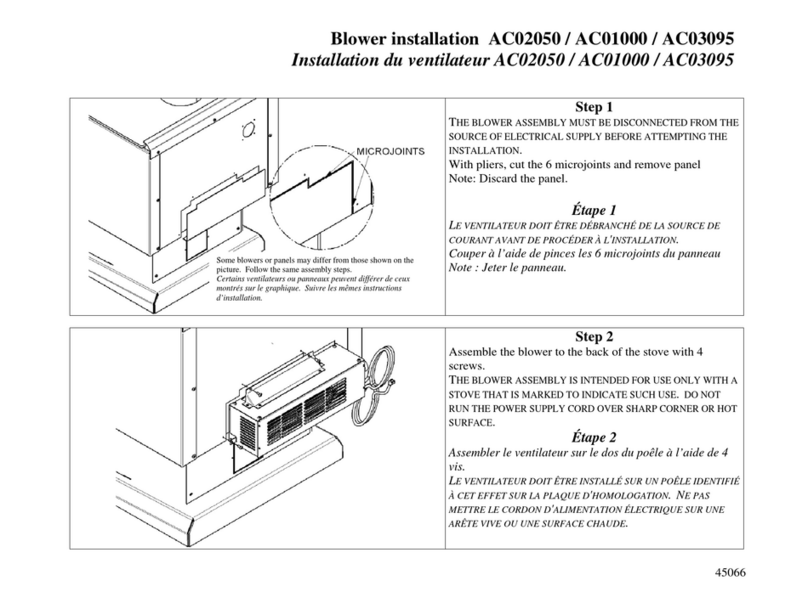
Drolet
Drolet A C03095 installation instructions

Primus
Primus Mimer Stove Duo Instructions for use
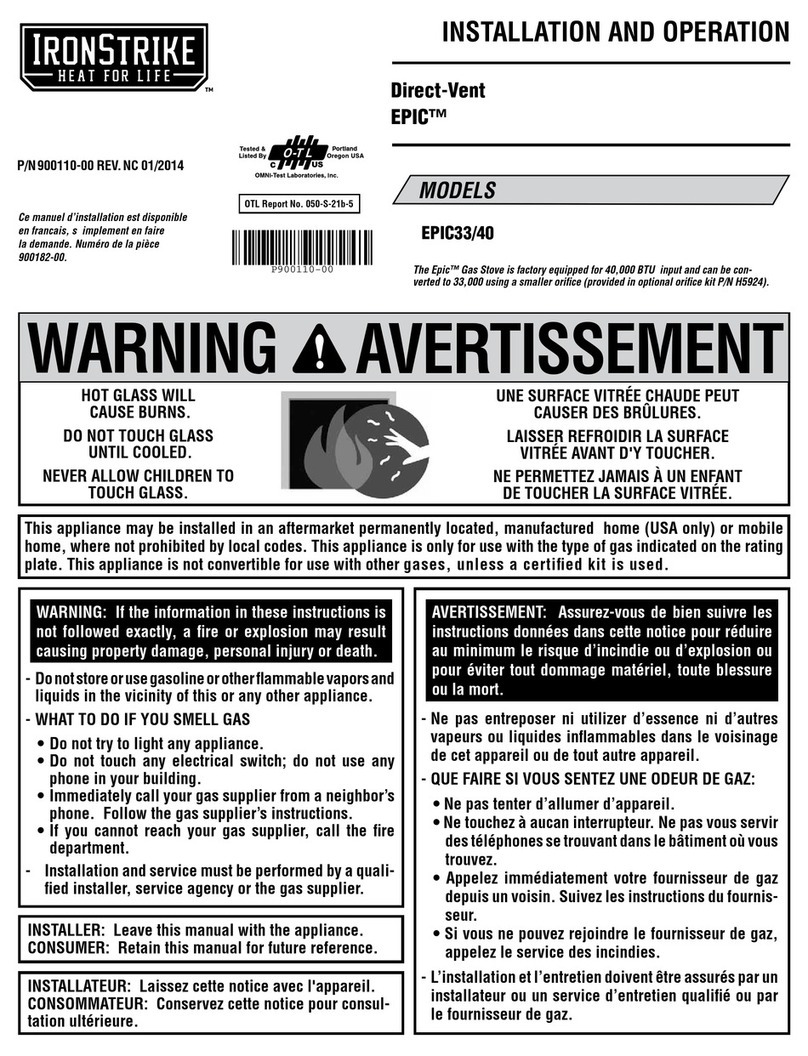
IronStrike
IronStrike EPIC33 Installation and operation guide

La Hacienda
La Hacienda 56063B User instructions
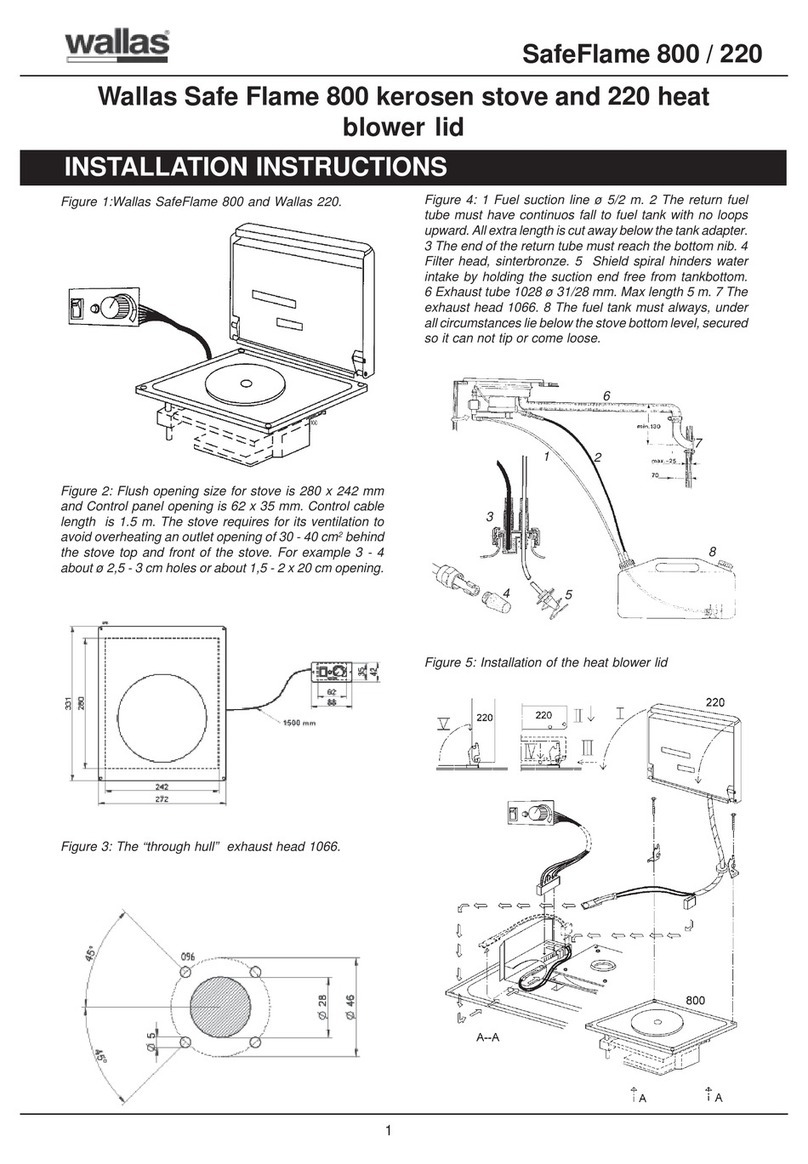
wallas
wallas Safe Flame 800 installation instructions
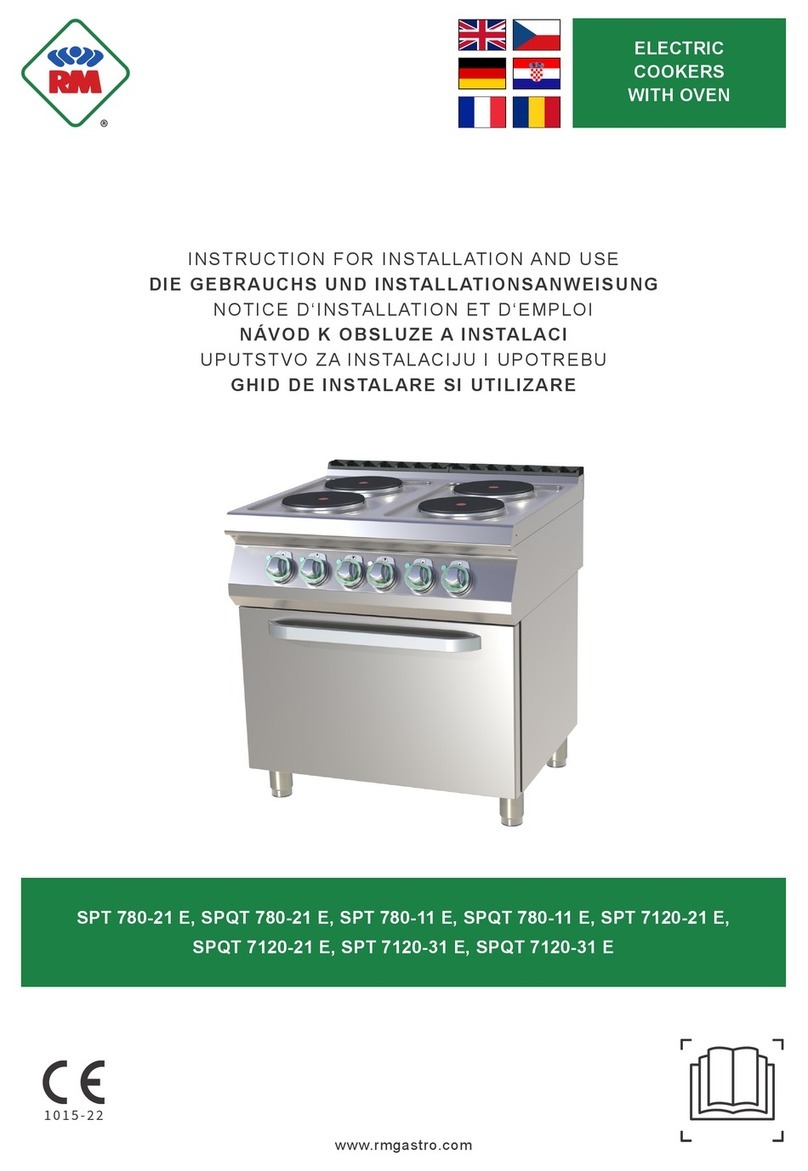
RM Gastro
RM Gastro SPT 780-21 E Instructions for installation and use
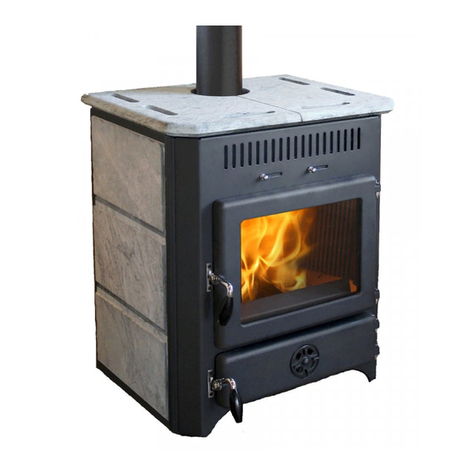
MBS
MBS THERMO VULKAN Manual instruction

Dometic
Dometic HOT & COOKING CS102 Installation and operating manual
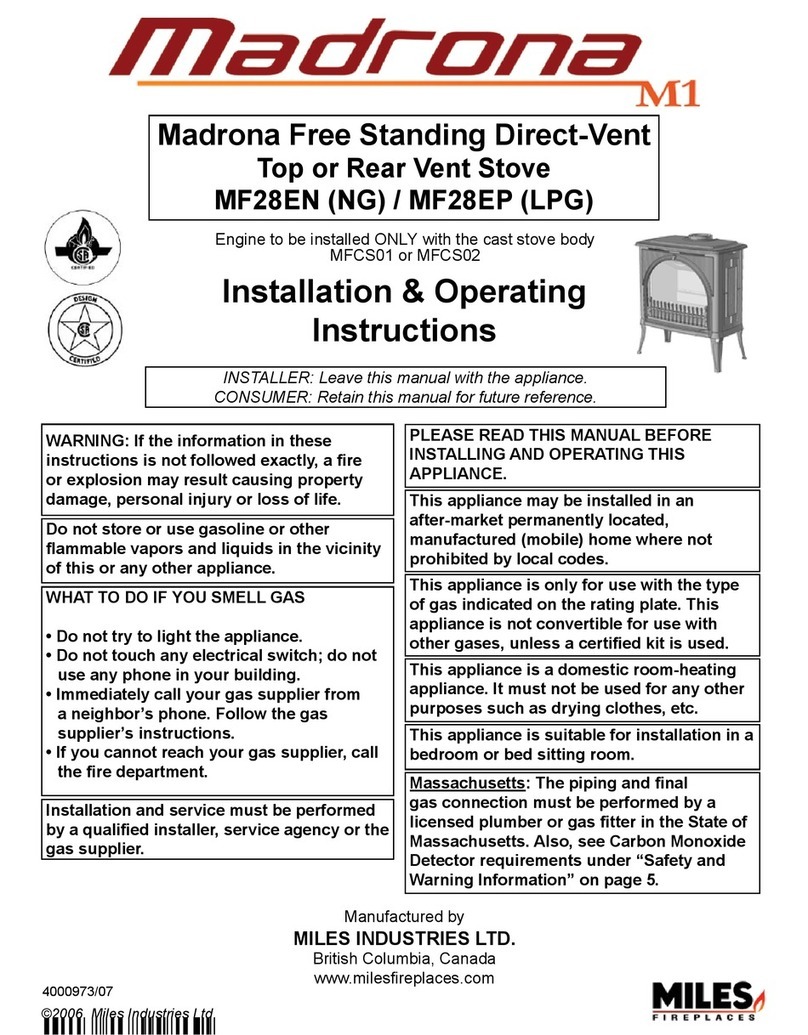
Miles Industries
Miles Industries Madrona MF28EN Installation & operating instructions
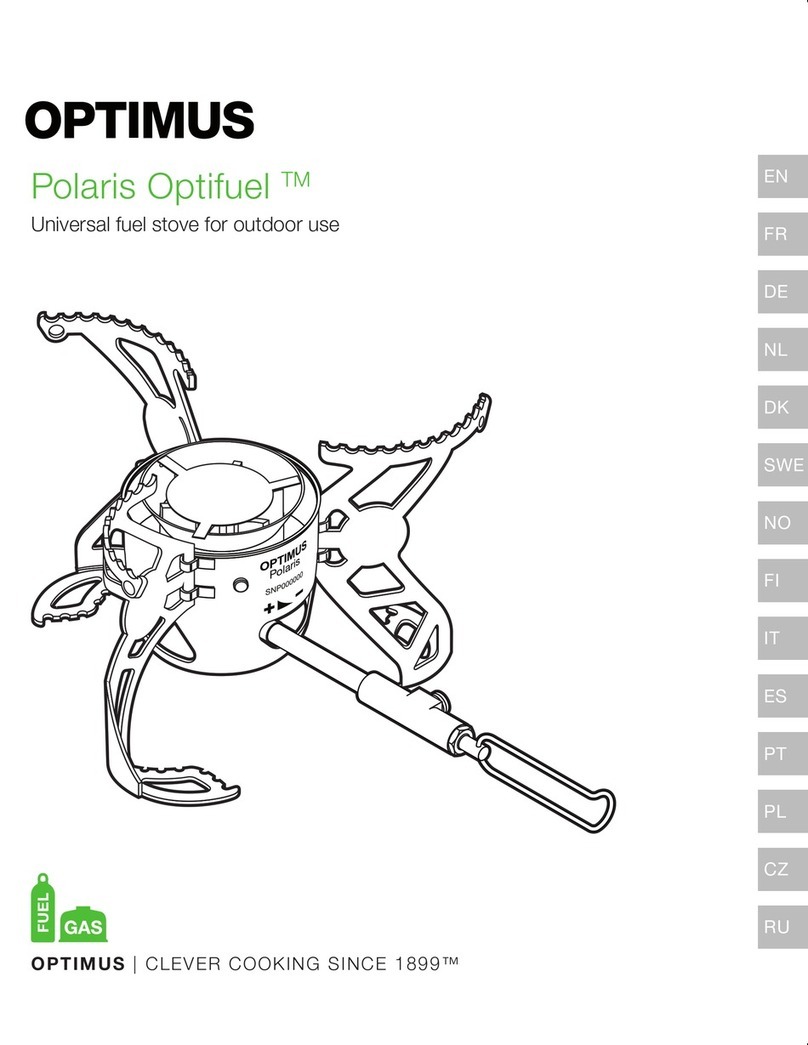
Optimus
Optimus Polaris Optifuel manual

RIKA
RIKA Domo manual

Drolet
Drolet ULTRA FLAME DIRECT VENT GAS STOVE Installation and operating instructions




